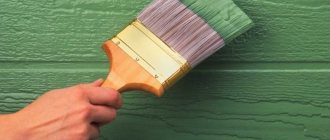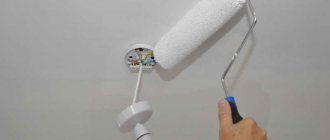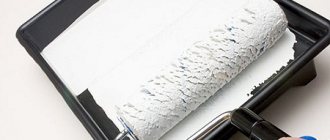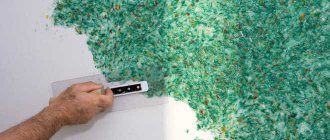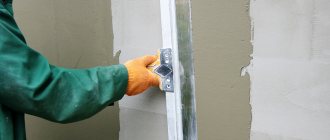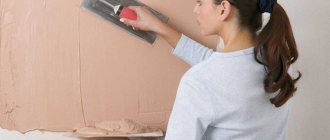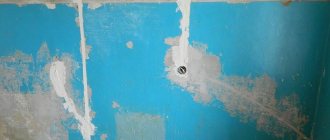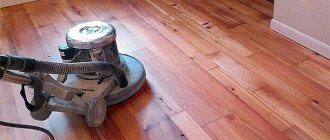Acrylic paint is actively used for painting almost any surface, it is highly wear-resistant, does not contain toxic substances, and dries quickly. In some cases, the paint is varnished to provide reliable protection from various influences, humidity, precipitation or temperature changes. Wooden surfaces are usually treated with varnish to protect the material from moisture.
Also, using varnish, you can give the surface an unusual decorative effect.
Basic rules for working with varnish
- When purchasing varnish, you need to pay attention to the expiration date, which should not be more than 90 days. This will make the application work easier.
- Acrylic paint adds shine to the surface, since it already contains varnish. Therefore, it is not necessary to varnish acrylic paint, but you can create additional protection.
- Before the main work, you need to check that the paint is completely dry. There should be no dust, dirt or other debris on the surface. If surface cleaning work is carried out shortly after applying paint, do not scrub the areas vigorously. Do not use rough materials, such as rags or sponges.
- The varnish cannot be applied to a clean surface; it is treated with a primer, this helps prevent cracking of the product during operation. Varnishing is carried out on a completely dry surface .
- Before use, the varnish is heated to 50 degrees; for this, it is placed in a liter of boiling water. The product reaches this temperature within five minutes.
- It is necessary to coat the surface with varnish in good lighting from above and from the side to the right. Thus, the entire process of performing the work is more clearly visible.
- For application, use a fluted brush with wide bristles from 50 to 150 millimeters. This allows the work to be completed evenly and with better quality.
- When a small area is covered with varnish, polishing is performed, that is, a dry flute brush is carried vertically across the surface until it sticks. Once the brush starts to stick, you can continue covering the rest of the surface.
- While the varnish is drying, dust should not fall on its surface. Acrylic-based varnish dries very quickly. If the place is too dusty, cover it with film.
- When working with acrylic-based varnish and paints, there is no need for protective equipment, since the materials are non-toxic.
- To apply paint, use a brush, roller or spray gun; the surface must be completely dry, only then varnish is applied.
- When choosing a varnish, it is necessary to take into account its correspondence with the paint, that is, for acrylic paint, an acrylic-based product is used, this makes it possible to make the surface better without changing the main color.
Why do you need to varnish surfaces?
Applying varnish to a surface painted with acrylic paint may be advisable if it is wooden and susceptible to moisture. For example, a wooden table outdoors or any other wooden product intended for a room with high humidity (ground floor, basement, bathroom).
Moreover, wood is deformed under the influence of the environment. It may be susceptible to attack by pests.
And in order to avoid unpleasant surprises, it makes sense to protect wooden surfaces and products with additional protection.
Why varnish
It has been established that acrylic paint is classified as one of those types of finishing compositions that do not require varnishing. It already contains varnish. It can independently counteract the influence of moisture.
Varnishing is a desire to achieve increased strength.
Many people ask whether it is necessary to varnish the paint. The material being processed plays a role. For wood painted with acrylic, protection is considered optimal. Wood is afraid of water, is easily exposed to high and low temperatures with subsequent defects, and is not able to resist various pests in its pure form. Painting and varnishing provide double protection.
Varnishing wood
After the primer has completely dried, paint the surface.
- First, prepare the coloring agent and mix it well. If necessary, pigment is added to create the desired color. Is it possible to glue wallpaper onto fiberglass without putty? To thoroughly mix the pigment and paint, use a construction-type mixer.
- Then they begin to paint the surface. Apply a thin layer of paint with a brush; no streaks should form on the surface. Instead of a brush, you can use a roller.
- When the first application dries, proceed to the second coating.
After this, the surface is considered prepared for varnishing.
Preparation for varnishing
Before applying the varnish, preparatory work is done. In order for everything to look beautiful in the end, the surface to be varnished must be checked for defects. These include minor scratches, chips, cracks, and dried stains.
Having identified the presence of defects, they are removed. Selected areas are sanded with fine-grained sandpaper and degreased. Sanding is done carefully. The paint should not be completely erased.
Prime with a primer. Finish acrylic paint is applied. Use a roller or brushes. Tools must be durable. The roller should have strong pile. Hairs should not fall out of the brushes. If you use low-quality tools, you will end up having to repeat the preparation. Lint or brush hairs may stick to the surface. They will have to be cleaned again.
Preparing varnish before work
What it is?
This composition is a mixture of synthetic resins and natural solvents. The components of the varnish provide it with a high level of adhesion and resistance to moisture.
The quality requirements for alkyd products establish certain standards that the composition must meet - first of all, the varnish must be colorless and form a glossy or matte protective layer on the surface. Some products may have a certain shade. The mixture allows you to increase the aesthetic appeal of the base, emphasizing the depth of color, which is important, for example, for a parquet floor.
As a result of use, the treated surface becomes more attractive. Is it possible to apply acrylic paints to a varnished surface? However, the choice of a particular product should be based on personal preferences and the area of use of the surface.
Alkyd varnishes differ somewhat in their specificity and chemical content, depending on whether they are used for interior or exterior use.
Alkyd mixtures are widely in demand in comparison with their analogues. This is due to the performance properties of the products, which are several times higher than the existing indicators of oil compositions.
Properties of acrylic enamels
Acrylic enamels consist of a binder base, solvent, filler, and additional substances. The composition may contain pigment.
The binding base is a polymer material. Acrylic resin is used for its production. The quality of the resin affects the characteristics of the finishing material.
The solvent used in acrylic paints is water or special thinners that speed up drying.
Various substances are used as fillers: ground talc, sand, dusted quartz, asbestos dust, fiber. The type of filler affects the properties of the material. Pigments add color and increase service life.
- do not change under the influence of ultraviolet radiation, temperature and humidity;
- dry quickly;
- safe, no pungent odor;
- have a long service life;
- resistant to aggressive chemicals.
Thanks to this, the paint protects objects from corrosion. Does not fade in the sun, is not subject to mechanical damage, and does not peel off under the influence of temperatures. Used for work inside buildings and outdoors. Before applying paint, the surface is cleaned, degreased and covered with primer.
Features of MDF varnishing
When finishing furniture and doors, varnish is used to give products a more interesting color and protect them from damage. MDF fiberboards differ from natural wood in structure, so a two-component varnish is suitable for processing them. With its help, it is possible to give products an unusual effect and make the material resistant to temperature and moisture.
Requirements that varnish for coating MDF panels must meet:
- two-component, odorless product;
- moisture resistance and heat resistance;
- high antiseptic characteristics;
- optimal drying time – up to 72 hours;
- operating temperature of use – +5+25°C;
- content of volatile substances within 20%;
- material consumption rate - up to 0.5 kg per 1 m 2.
MDF panels can be coated with a synthetic product to achieve a glossy effect, or water-based acrylic varnish can be used to give the surface a matte finish. The coating is applied to the slabs with a brush or spray.
Preparation and varnishing of MDF includes the following steps:
- Before varnishing, a primer is applied to the MDF panels and the damaged areas are treated with putty.
- The product is sanded with fine-grained sandpaper and a second layer of primer is applied.
- They are varnished, difficult areas are treated with a brush, and then the main part of the furniture facade, panel or door is varnished.
Since the varnish for MDF is based on two components, before work they are combined and stirred with a construction mixer, and the mixture must be filtered. The prepared working solution must be used within three hours. Can it be used later? Not recommended.
How to determine what material a wall is covered with
To determine the type of coating, various methods can be used:
- The easiest way to determine whitewash. To do this, run your palm along the wall - if a white mark remains on the skin, it has touched the chalk solution.
- Acrylic or water-based paint can be determined by moistening the wall. If it does not change shade, the coating is made of a water-based mixture. Darkening indicates lime whitening.
- Latex paints. To determine them, they also use water, washing the wall with a rag. If an area of the surface washes out without problems, it is chalk mortar or acrylic-based paint. If there are no signs of dissolution, latex paint is used for the surface.
- Enamel stains can be identified by carefully inspecting the wall. Its surface in this case is shiny, with a slight gloss.
- It is not easy to distinguish oil paint from enamel paint, but the same mixtures can be used for it.
When treating walls and other surfaces before painting, it is recommended to use materials with the same type of binder. This is especially important for mixtures that are characterized by chemical curing (polyurethane, epoxy). To ensure adhesion of the layers, during the application of each layer it is necessary to carefully follow the recommendations for drying them.
Securing gouache with varnish
When performing creative woodworking, creating decorative objects from plaster, painting and decoupage, artistic paints are used. After application, the gouache must be fixed so that the paint layer is resistant to abrasion, cracking and moisture. Some paints under incorrectly chosen varnishes “float” and become smudged. To avoid this, cover the design (ornament, pattern) with acrylic or alkyd paint.
The procedure for working with acrylic varnish:
- Traditionally, gouache varnishing is done using wide synthetic brushes with long bristles. Some artists use aerosols to avoid smudging the gouache.
- The use of a roller, sponge and sponges is appropriate only if it is necessary to obtain a certain decorative effect. Tools for work must be dry and clean.
- Select an effect. The glossy composition gives a pleasant shine, but when exposed to light, the work will reflect glare. Matte varnishing can mute the shades. The output is a semi-matte composition.
- When using a brush, the tool is dipped in varnish and squeezed well on the edge of the container. The varnish is applied with intense strokes. The acrylic composition is white, the treated areas are clearly visible.
- To achieve the desired effect of a varnished surface, several thin layers can be applied, allowing a drying interval of two to three hours.
Some products decorated with artistic painting using gouache are often used in everyday life. How to fix gouache so that the coating lasts longer? It is recommended to perform multi-layer varnishing. To do this, acrylic varnish is applied at least ten times, dried and lightly processed with fine sandpaper.
Some craftsmen use strong-hold hairspray to fix gouache; they use polyurethane compounds, furniture and yacht varnishes. The choice of product also depends on the color saturation of the gouache. Thus, red gouache under nitro varnish will flow, and light paints may acquire a yellowish tint when using alkyd PF compositions.
Types of varnish by composition
- Acrylic-based varnish is safe and does not emit toxic substances harmful to health. This type of product is used for interior work, has a transparent appearance, can be applied to a wooden surface without changing its color, and dries quickly.
- Nitrovarnishes are also used for indoor work; they are toxic, so the coating is carried out in a protective mask. This product dries quickly.
- Alkyd types of varnish can be used for external and internal work. They contain resins and organic solvents. Such varnishes are water-repellent, can be used on various surfaces, and have a long drying time.
- For wood surfaces, universal type polyurethane varnishes are used; it protects the surface from mechanical action, that is, from scratches or failures.
- There are varnishes that are based on vegetable oil; they take a long time to dry and can give the wooden surface a yellowish or brownish tint.
- Epoxy varnish is resistant to moisture and mechanical damage, I use it inside and outside, it dries in about 12 hours.
Why determine whether the paints on the surface are compatible with the paint used?
Paint and varnish materials often have to be applied to a surface that is already covered with some kind of paint and varnish material. These can be primers, putties, various enamels. They may differ in the pigments included in the composition and in the film-forming base. In order for the surface to be painted successfully, and for it to acquire an attractive appearance, it is necessary to ensure that the materials are compatible with each other.
If you attempt to coat over a material that is not compatible, the resulting surface will be of poor quality. Its appearance will be spoiled, and it is possible that soon after drying the paint will begin to crack and fall off. The composition will need to be removed soon and the painting work will need to be done again. This is not only time-consuming, but also very costly financially.
Properties of alkyd enamels
Alkyd enamels contain alkyd varnish, solvents and various fillers. May include a coloring pigment.
Pentaphthalic varnish, which is a thick resin, is most often used in production.
To regulate the viscosity of paints and varnishes, the solvent white spirit, which is obtained from oil refining, is often used.
Granite or marble chips and fine sand are used as filler. Additional agents - antiseptics, antifungal elements. Alkyd enamel can be matte, glossy or semi-matte. Applied to objects, it protects surfaces from snow, rain, moisture, scratches, chips and other mechanical influences. Alkyds dry quickly. Can be used outdoors, indoors.
- do not change under the influence of atmospheric phenomena;
- dry quickly;
- can be used for painting any surfaces: metal, wood, plaster, etc.;
- applied evenly to a cleaned and primed surface;
- the color scheme has different shades;
- fade in the sun;
- may crack when exposed to temperatures;
- They have a pungent odor and require ventilating the room after use.
